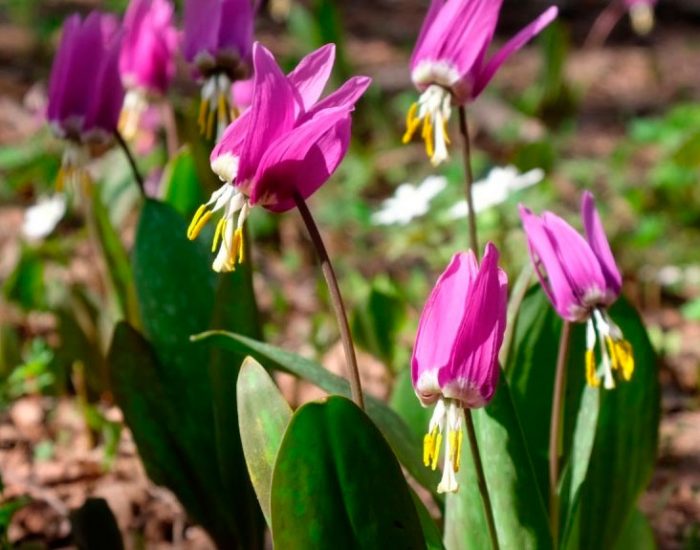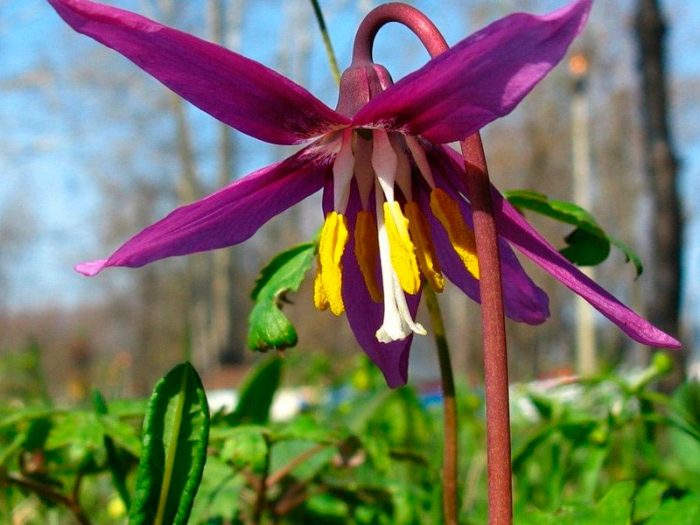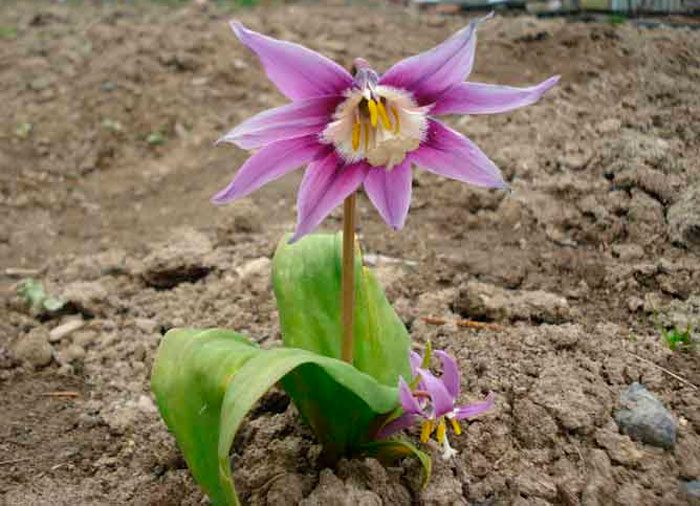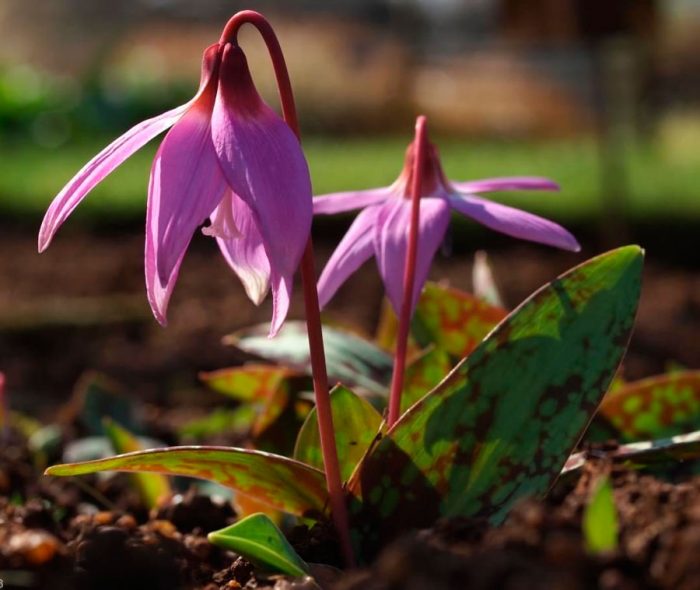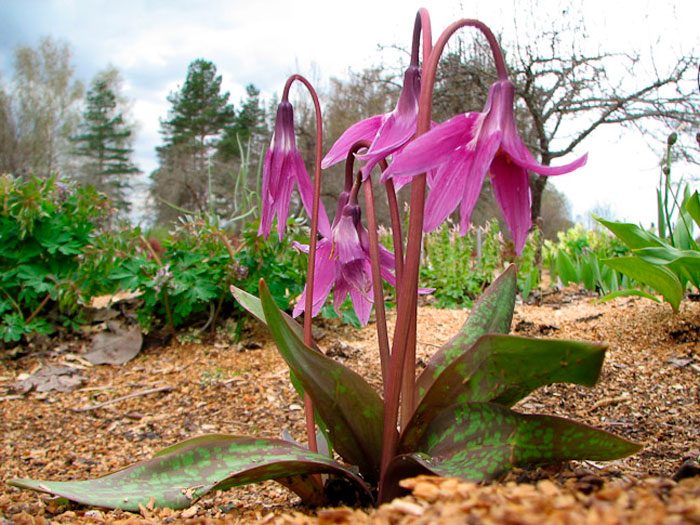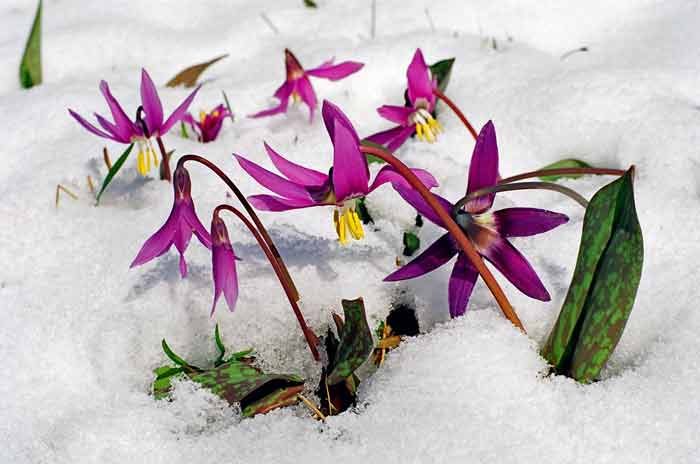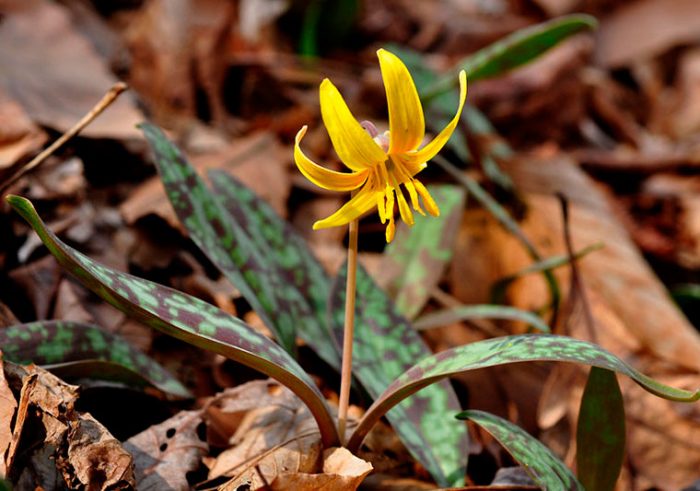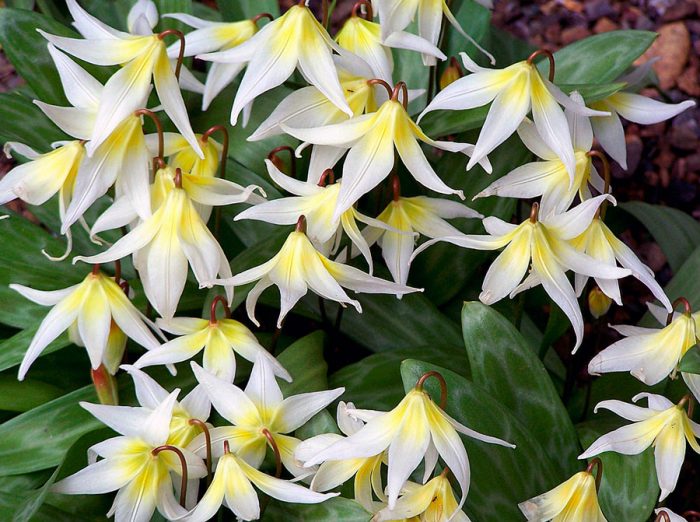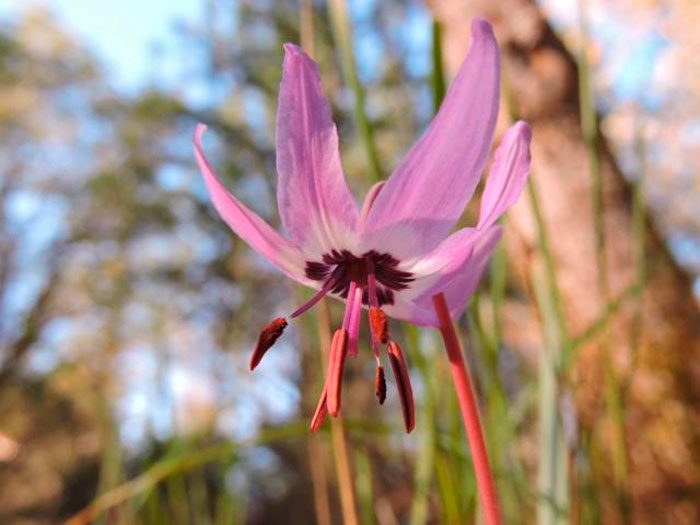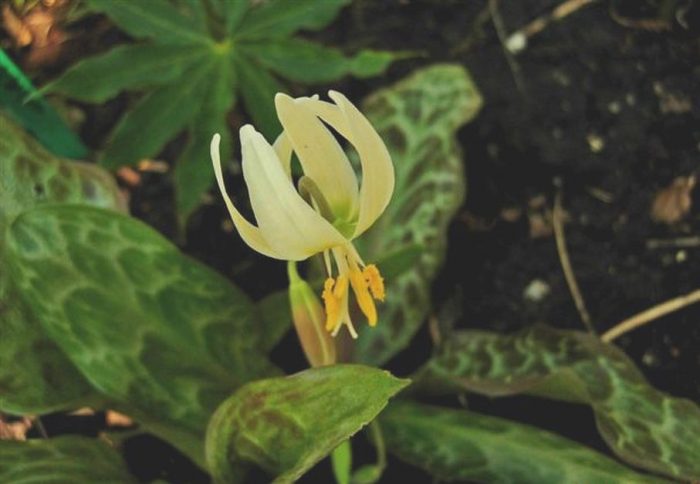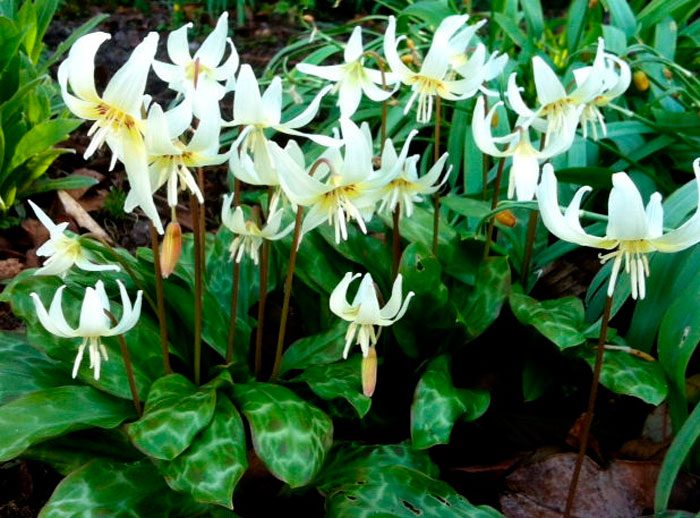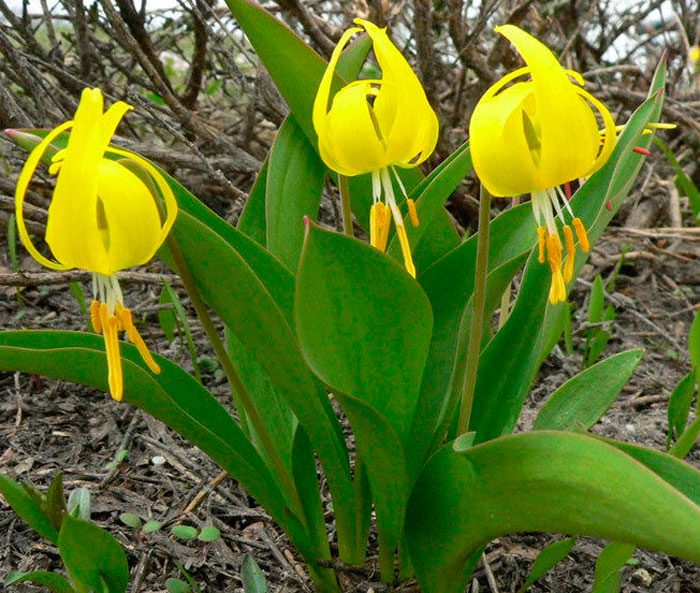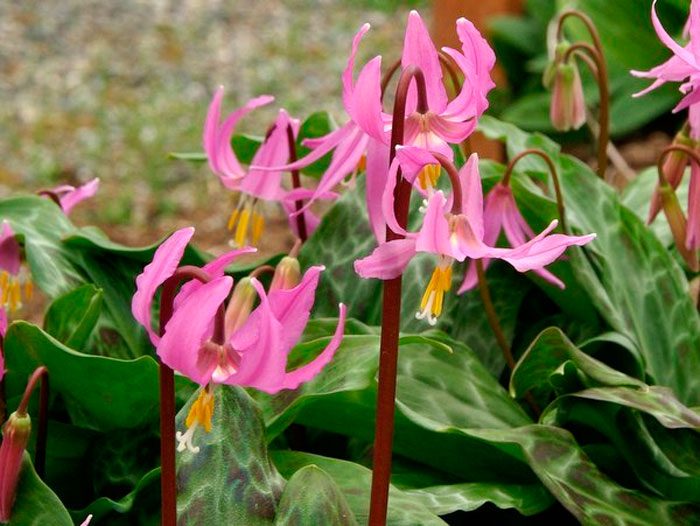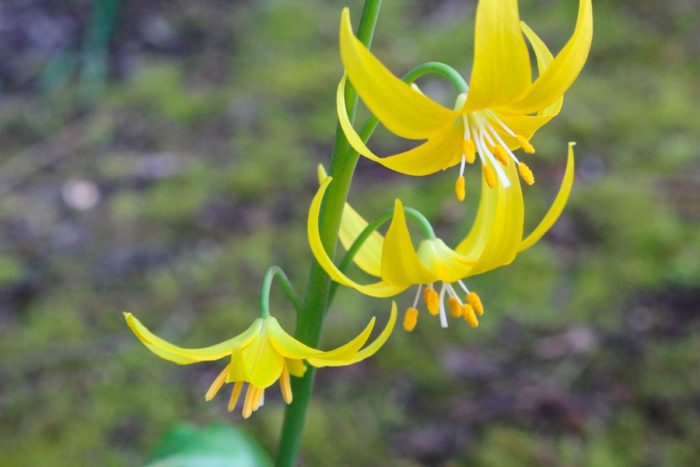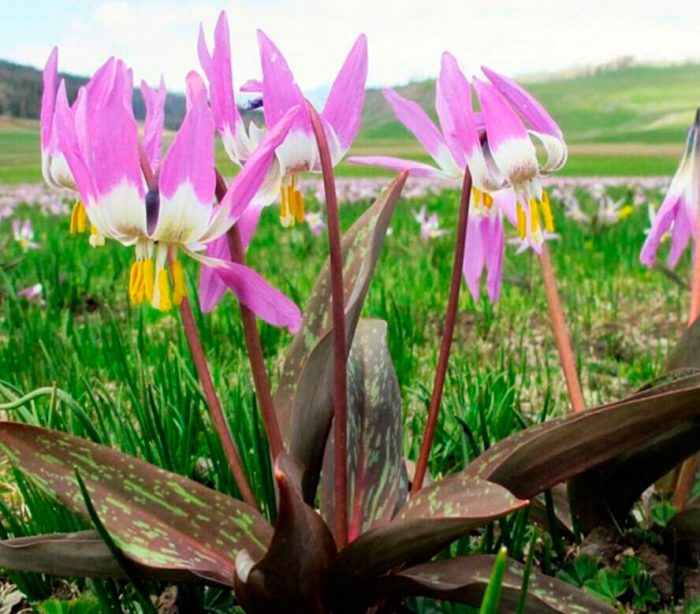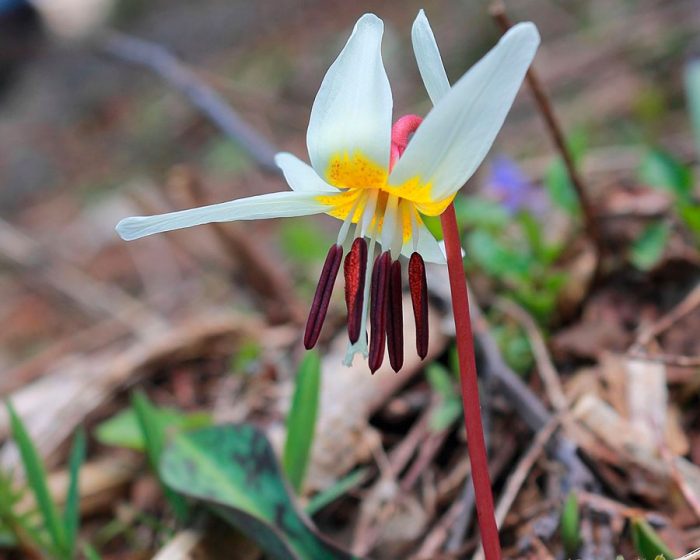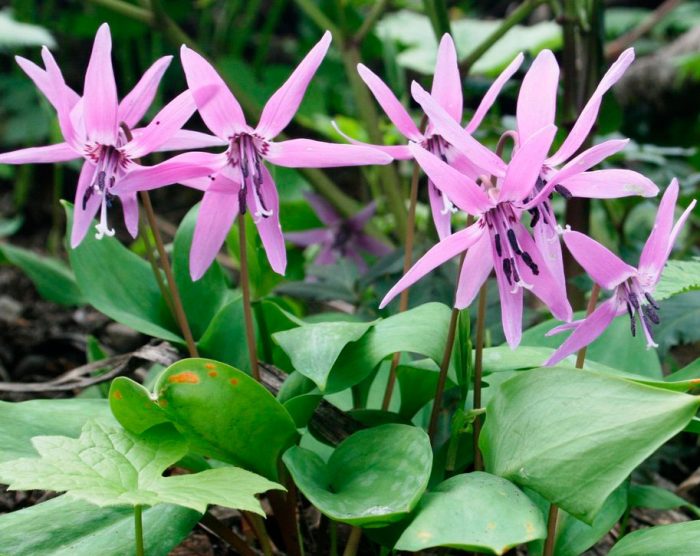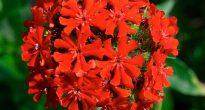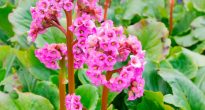The herbaceous perennial plant kandyk, also called Erythronium, is a member of the Liliaceae family. This plant can be found in natural conditions in Europe, Manchuria, North America, South Siberia and Japan. In the writings of Dioscorides, one can find a mention of the kandyk, which is an early spring ephemeroid. Karl Linnaeus gave this genus a Latin name, and it was formed from the Greek name for one of the kandyk species. And the name "kandyk" comes from the Türkic word, which means "dog's tooth". Species such as Japanese, Caucasian and Siberian kandyk are endangered, therefore they were included in the Red Book. This genus unites 29 species, some of which are cultivated by gardeners.
Content
- 1 Features of kandyk
- 2 Planting erythronium in open ground
- 3 Kandyk care in the garden
- 4 Types and varieties of kandyk (erythronium) with photos and names
- 4.1 American Erythronium (Erythronium americanum = Erythronium angustatum = Erythronium bracteatum)
- 4.2 Erythronium whitish (Erythronium albidum)
- 4.3 Erythronium multistem (Erythronium multiscapoideum = Erythronium hartwegii)
- 4.4 Erythronium hendersonii
- 4.5 Erythronium mountain (Erythronium montanum)
- 4.6 Kandyk lemon yellow (Erythronium citrinum)
- 4.7 Erythronium californicum
- 4.8 Kandyk large (Erythronium grandiflorum)
- 4.9 Erythronium oregonum, or erythronium turned away or wrapped up (Erythronium revolutum)
- 4.10 Erythronium tuolumnense
- 4.11 Erythronium Siberian (Erythronium sibiricum = Erythronium dens-canis var.sibiricum)
- 4.12 Erythronium caucasicum
- 4.13 Erythronium European (Erythronium dens-canis), or dog tooth (Erythronium maculatum)
- 4.14 Japanese Erythronium (Erythronium japonicum)
- 4.15 Erythronium hybridum (Erythronium hybridum)
- 5 Properties of kandyk: harm and benefit
Features of kandyk
The kandyk plant most often has a height of 0.1 to 0.3 m, in rare cases it can reach 0.6 m. The shape of annual bulbs is ovoid-cylindrical. At the base of the peduncle there are two opposite petiole leaf plates, the shape of which is elongated-lanceolate, most often on their surface there are a large number of specks of brown color, but there are also monotonous green. At the top of the peduncle, a flower grows with a drooping large perianth, it contains 6 leaves of white, yellow or purple-pink color. In some cases, several flowers grow on the arrow. Kandyk blooms in the last days of April or the first days of May. The fruit is an egg-shaped capsule containing some seeds.
Planting erythronium in open ground
What time to plant
Erythronium, which begins to bloom in the first days of April, is recommended to be planted in a shaded place in the northern part of the garden area under the lacy crowns of shrubs and trees.Since the bushes bloom at a time when there is still no foliage on the bushes and trees, they have enough sunlight. Those species that bloom in the last days of April should be planted in a sunny area. If everything is done correctly, the late varieties will begin to bloom earlier, and the early ones - on the contrary, later.
The soil suitable for planting should be peaty, moist, light and slightly acidic, its approximate composition is: leafy earth, coarse sand and humus. The preparation of the site should be done half a month before planting, for this, 200 grams of bone meal, 30 grams of potassium nitrate, 100 grams of crushed chalk and 150 grams of superphosphate per 1 square meter of the site must be added to the soil.
Kandyk is propagated by seeds, as well as by children. All American species can be propagated only by seed, in addition to the multi-stemmed kandyk. Seeds are collected in June, and you need to be very careful, since after full maturation, the capsules open up, and their contents appear on the surface of the site, after which they can be pecked by birds or dragged away by ants. Experienced gardeners recommend cutting off the slightly unripe bolls, after which they are placed for ripening in a well-ventilated dry room. Sowing seeds and planting bulbs in open soil are carried out in the last summer weeks.
Landing rules
Before you start sowing the kandyk, you need to make grooves 30 mm deep, and the distance between them should be about 100 mm. Then the ripe seeds are placed in the prepared grooves, while a distance of 50 mm should be kept between them. Then the seeds need to be repaired. Crops need abundant watering. The site will need to be covered only when forecasters promise that the winter will be frosty and little snow. The first seedlings should appear in spring, while in the last days of April their height should be at least 40 mm. In the event that the seedlings are not so tall, then this means that they lack nutrients and water. At the end of the first season, the diameter of the bulbs is 40 mm, and at the end of the second, about 70 mm. And during the third season, their shape becomes cylindrical, after which they themselves sink into the ground by 70–100 mm, and in diameter they reach 80 mm. For the first time, the bushes that have grown from seeds bloom 4–5 years after the seedlings appear.
It is possible to sow seeds in springtime, but they need preliminary stratification. To do this, the seed must be placed on a refrigerator shelf for vegetables for 8-12 weeks, but first they must be poured into a plastic bag filled with moistened peat or sand.
As mentioned above, these flowers can be grown from bulbs. Moreover, each species has its own characteristics of vegetative reproduction. Bulbs of American species must be buried in the soil by 16–20 centimeters, while the distance between them must be at least 15 centimeters. And Asian-European species need to be buried into the ground by 10-15 centimeters, and the distance between them must also be left at least 15 centimeters. When the bulbs are planted, the site must be covered with a layer of mulch, and they also need abundant watering.
Kandyk care in the garden
It is relatively easy to grow a kandyk in your garden. This culture is rarely watered. And if you want to reduce the number of weeding and loosening, then the surface of the site must be covered with a layer of mulch.
How to water and feed
The beginning of the intensive growth of this flower occurs in early spring. At this time, after the melting of the snow cover, the ground contains a large amount of melt water. In this regard, the kandyk will have to be watered only in May, and then if there is very little rain in the spring. After the bushes are watered or the rain has passed, you need to systematically loosen the surface of the soil around them shallowly, while pulling out all the weeds.
In the first year, such flowers do not need to be fed, because they have enough nutrients that were introduced into the ground before sowing seeds or before planting bulbs. In subsequent seasons, it will only be necessary to cover the surface of the site with a layer of mulch (deciduous humus or peat). Also, for feeding this culture, you can use mineral fertilizers for decorative flowering plants.
How to transplant and propagate
For 4 or 5 years of growth in one place, the bush turns into a "nest", so it will be necessary to transplant it. Transplanting a kandyk, it is propagated by the method of dividing the bulbs. It is recommended to carry out this procedure in July or August, at this time the kandyk has a period of rest. By the time of transplantation, the leaves of the bushes should turn yellow, while the bulbs should have time to recover their strength spent on flowering. Separated, from the bulbs removed from the ground, the children must be planted in the grooves prepared in advance in the same way as described in detail above. At the same time, do not forget to sprinkle the places of fractures with coal powder. It should be noted that the bulbs cannot stay in the air for a long time, since, due to the lack of covering scales, they begin to dry out almost immediately. In the case when the bulbs need to be removed for storage, then for this they take a box, which is filled with moistened sphagnum, sand or peat, into which they are buried.
You can read about all the features of the generative (seed) reproduction of such a plant above.
Erythronium in winter
Kandyk has a fairly high frost resistance, so when grown in the garden, it can winter in open soil. But if a frosty and little-snow winter is ahead, then the kandyk will need shelter, for this the site is covered with a sufficiently thick layer of spruce branches or dried foliage. It is necessary to remove the shelter only at the beginning of the spring period, after the snow cover melts.
Diseases and pests
Kandyk has a very high disease resistance. Among pests, moles, mice and bears are the most dangerous for him. Experienced gardeners recommend planting these flowers in various places of the garden plot, this will prevent the death of all specimens. To get rid of pests, you need to make traps. To catch a bear, it is necessary to make a hole on the site in which fresh manure is placed, in which this pest prefers to lay eggs. The holes from above must be covered with slate or a board, after a while you need to check the bait and, if necessary, destroy it along with the bears. Lures with special poison will help get rid of rodents.
Types and varieties of kandyk (erythronium) with photos and names
Below we will describe those types and varieties of kandyk that are most popular with gardeners.
American Erythronium (Erythronium americanum = Erythronium angustatum = Erythronium bracteatum)
Under natural conditions, this species is found in the warm-temperate and subtropical zones of the eastern, as well as central regions of the United States and Canada. They can be found in the mountains at an altitude of 1.5 thousand meters above sea level. The shape of the bulb is ovoid. The length of lanceolate or oblong leaf plates is about 20 centimeters, and their width is about 5 centimeters, their surface is strewn with specks of brown color. The height of the peduncle is about 0.3 m. The color of the tepals is rich yellow, in some cases with a purple tint.
Erythronium whitish (Erythronium albidum)
Under natural conditions, this species can be found in the central regions of Canada and the United States of America. Outwardly, this plant is similar to American erythronium. At the base of the tepals there are no lobes, and their color can be pink, purple, white or blue.
Erythronium multistem (Erythronium multiscapoideum = Erythronium hartwegii)
This species prefers to grow in light forests, and also on moist rocks of the subtropical and warm temperate zones of the southwestern part of the United States of America. At the base of the oblong-ovoid bulb, stolons are formed. On the surface of the lanceolate leaf plates, there are many spots. Located on long stalks, the yellow-cream flowers have an orange base, which changes to pink in the process of wilting. 1–3 flowers grow on a peduncle.
Erythronium hendersonii
Native to the light forests and dry grasslands of Oregon. It came to the territory of Europe in 1887. The oblong onion has a short rhizome. On the leaf blades there are specks of a dark brown color. Shoot height 10-30 centimeters, it grows 1-3 flowers of a pale purple color with an almost black base. The color of the stamens is purple, and the anthers are brownish.
Erythronium mountain (Erythronium montanum)
In nature, this species is found in the northwestern United States, while it prefers to grow in alpine meadows. The narrow bulb has an oblong shape. The height of the stem is about 0.45 m. On the winged petioles there are oblong leaf plates of an ovoid shape, they sharply taper towards the base. On the arrow, from one to several flowers of a pale pink or white color grow, while the base of the bracts is colored orange.
Kandyk lemon yellow (Erythronium citrinum)
This species grows in the warm-temperate zone in the western United States, while it can only be found in mountain forests. There are spots on the surface of obtuse broad-lanceolate leaf plates, and they also have short petioles. The apex of the plates is also short and pointed. The height of the stem is about 10–20 centimeters, 1–9 flowers of a lemon-yellow color grow on it, the tepals with an orange base are strongly bent back. As the flowers wither, the tips of such leaves turn pink.
Erythronium californicum
This species is found naturally in light forests in California. On the winged petioles, there are obtuse oblong leaf plates, there are spots on their surface, and their length reaches 10 centimeters. The stem height is about 0.35 m, from one to several flowers grow on it. The tepals have a white-cream color with an orange base. This species has a garden form with two-colored flowers: white and yellow-cream color. The following hybrids are most popular with gardeners:
- White Beauty... Large snow-white flowers have a dark brown ring in the middle. The curled tepals are shaped like a Chinese pagoda.
- Harvington Snowgood... In large flowers, cream-colored tepals have a lemon-yellow base.
Kandyk large (Erythronium grandiflorum)
In nature, the species is found in the steppe regions of the USA and Canada, but it prefers to grow on mountain slopes and in forests. The bulb is on a short rhizome. The height of the stem varies from 0.3 to 0.6 m. The oblong lanceolate leaf plates, smoothly turning into the petiole, are about 0.2 m long, and their color is solid green. 1–6 flowers grow on the stem, their tepals are yellow-golden in color, while their base is paler. This species has varieties and varieties:
- large-flowered white - the color of the flowers is snow-white;
- large-flowered golden - yellow anthers of flowers;
- large-flowered Nuttalla - flowers have red anthers;
- large-flowered pale - in this species, the anthers are painted white;
- Biyanka - white flowers;
- Rubens - flowers are painted pink-red.
Erythronium oregonum, or erythronium turned away or wrapped up (Erythronium revolutum)
In nature, this species can be found in the subtropical zone and the nemoral region of the Pacific coast of the United States and Canada. The height of the stem can vary from 0.1 to 0.4 m. The spotted leaf plates are oblong, lanceolate, tapering towards the petiole. The white-cream tepals are strongly curled, and at the base they are colored yellow, which changes to purple closer to the end of flowering. The color of the anthers is white. This species differs from others in its greater moisture-loving nature. Popular forms:
- wrapped white-flowered - the flowers are white with a slight pale green tint, the base of the perianth leaves is brown;
- wrapped by Johnson - the color of the flowers is dark pink, there are brown spots on the surface of the green glossy leaf plates;
- wrapped early - white-cream flowers have an orange base, on the surface of green leaf plates there are specks of mahogany color.
Erythronium tuolumnense
In nature, the species is found only in the foothills of the Sierra Nevada. The height of the bush is 0.3–0.4 m. The long-stemmed, monochromatic green leaf plates have a reverse lanceolate or lanceolate shape and a length of about 0.3 m. On the stem there are from one to several yellow-golden flowers, their base is yellowish-green. Popular varieties:
- Pagoda... The color of the flowers is yellow-lemon.
- Congo... This hybrid was created using the Uverted Kandyk and Tuolumni Kandyk. The flowers are colored sulfur-yellow. On the inner side of the perianth there is a brown ring, and on the surface of the leaves there are streaks of brownish red.
Erythronium Siberian (Erythronium sibiricum = Erythronium dens-canis var.sibiricum)
In the wild, such a plant can be found in Southern Siberia and Mongolia, while it prefers to grow along the edges of coniferous and mixed forests of Altai and Sayan. The egg-shaped cylindrical white bulb in this species is very fragile, in shape it is similar to a dog's canine. The height of the stem varies from 0.12 to 0.35 m, on it there is a pair of opposite green leaf plates of an elliptical shape, they are pointed towards the top, on their surface there is a marble pattern of brown-red color. A drooping flower grows at the top of the stem, reaching 80 mm in diameter, the perianth leaves are bent to the sides, they are painted in white or pink-purple color. The base of the leaves is yellowish, it is covered with small dots of dark color. The flower's pistil is white, and the anthers are yellow-golden. There are varieties with brown or almost brown leaf plates and a thin green border, but after a while the pattern disappears.
Erythronium caucasicum
This species is endemic to Western Transcaucasia, where it is found in mountain forests. The shape of the bulb is oblong or ovoid-cylindrical. The height of the stem is about 0.25 m. On the surface of the gray oblong-ovate leaf plates there are specks, their petioles are stalk-enveloping. The base of the tepals is yellowish or white. The inner surface of these leaves is pale yellow, and the outer surface is purple-orange. This species has a low resistance to frost, therefore, the bushes must be covered for the winter.
Erythronium European (Erythronium dens-canis), or dog tooth (Erythronium maculatum)
This flower prefers to grow in shrubs and mountain deciduous forests in the subtropics and the warm-temperate zone in Europe (it also occurs in the western regions of Ukraine), in the Alps it can be found at an altitude of 1.7 thousand meters above sea level. The color and shape of the bulbs is similar to the canine of a dog. The height of the pale pink stem is 0.1–0.3 m. Green broad-lanceolate leaf plates taper to grooved petioles, they grow at the base of the stem, and on their surface are specks of purple color.On the stem grows 1 drooping flower, pointed lanceolate tepals, bent back, painted in purple, pink, less often white. On short stamens there are anthers of a dark blue almost black color. This species is distinguished by frost resistance and high decorativeness, has been cultivating it since 1570. There are 2 varieties:
- niveum - snow white flowers;
- longifolium (long-leaved form) - it has more flowers than the main species, and the leaf plates are pointed and long.
The most popular varieties are:
- Charmer... This variety was bred by Thunbergen in 1960. There is a large brown spot at the base of the flower. The color of the perianth is lavender. There are brown markings on the surface of the foliage.
- Frances Halls... The outer surface of the perianth is one-colored purple, and on the inner surface there are greenish-bronze specks. The central part of the flower is green-yellow.
- Lilac Wonder... In this cultivar, the flowers are purple in color, at the base of the perianth leaves on the inner surface there is a chocolate ring, and on the outer one - brown.
- Pink Perfection... This early variety has a deep pink perianth.
- Snowflake... The flowers of such a garden form are snow-white in color.
- Rose Queen... This variety is relatively rare. It is very showy and has pink flowers.
- White Splendore... This variety was bred by Tubergen in 1961. The flowers are white, and the perianth leaves have a brownish-red speck at the base.
Japanese Erythronium (Erythronium japonicum)
In nature, the species can be found on the Kuril Islands, Korea, Sakhalin and Japan. This type is highly decorative. The shape of the bulb is cylindrical-lanceolate. The height of the stem is about 0.3 m. The petiolate leaf plates are narrow and oblong, they reach about 12 centimeters in length. On the stem flaunts 1 drooping purple-pink flower.
Erythronium hybridum (Erythronium hybridum)
Here are collected varieties that were obtained by crossing various varieties and types of kandyk. Popular varieties:
- White king... The snow-white flowers have a lemon color in the middle, and there is also a barely discernible point pale red border. The color of the leaf plates is rich green.
- Scarlet... The rich crimson flowers have a white ring, and inside there is a ring consisting of crimson dots. The central part of the flower is pale yellow. There are green dots on the surface of the brown leaf blades, the upper part of them is also green.
- White Fang... The flowers are white with a pale yellow center; they reach about 60 mm in diameter. The flower stalk and foliage are green.
- Harmony... The flowers reach about 80 mm in diameter: the leaves are white closer to the base, and pink at the tips, the central part is yellowish and edged with red dots. On the surface of young green leaf plates there is a brown pattern, which disappears over time.
- Olga... On the surface of pink-lilac flowers there are dots of dark pink color, at the tips of the lobes there is a white edging. A green stripe runs along the edge of the green-brown leaf plates.
Properties of kandyk: harm and benefit
Useful properties of kandyk
Kandyk belongs to melliferous plants. The nectar of flowers contains glucose, enzymes, vitamin E, fructose, minerals, acids and other substances necessary for the human body. The honey of such a plant has a delicate smell and valuable medicinal properties, since it contains enzymes, vitamins and emollients. This honey is used in the treatment of fever, cough, and it also lowers the temperature. On the basis of this honey in cosmetology, antiseptic honey water is made, which does not dry the epidermis.
In alternative medicine, kandyk bulbs are also quite popular, since they contain higher alcohols and antispasmodics. With the help of fresh bulbs, convulsions can be prevented even in epilepsy.
Foliage has a general strengthening effect, it is able to stop the aging process, and it is also used to improve potency in men. It also contains a large amount of dietary fiber, vitamins, enzymes and minerals. The foliage is eaten fresh and also pickled. A decoction made from the herb of this plant is used to rinse the hair to strengthen the hair follicles.
Contraindications
Kandyk pollen can cause hay fever in a person prone to allergic reactions. If you have been near such a flower, and your sinuses are swollen, a runny nose and a rash appeared, then you should seek medical help as soon as possible. If you eat a lot of kandyk honey, then this can also cause health problems. The fact is that it increases appetite and increases blood sugar levels. Such a product should not be consumed by people suffering from diabetes mellitus, and also sensitive to glucose. Regular use of parts of such a plant or honey can cause the development of hypervitaminosis, especially if at the same time pharmaceutical multivitamins or dietary supplements containing vitamins are taken. Even a completely healthy person is advised to consult a specialist before using a kandyk for general strengthening of the body.

